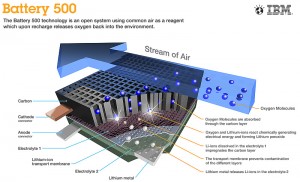
Today IBM announced that two industry leaders, Asahi Kasei and Central Glass, will join and collaborate on their Battery 500 Project. Back in 2009, IBM Research pioneered a sustainable mobility project to develop lithium-air battery technology, capable of powering a family-sized electric car for approximately 500 miles (800 km) on a single charge. With these new partners there is a great potential to accelerate the switch from gasoline to electricity as the primary power source for vehicles.
“These new partners share our vision of electric cars being critical components of building a cleaner, better world, which is far less dependent on oil”, said Dr. Winfried Wilcke, IBM’s Principle Investigator who initiated the Battery 500 Project. “Their compatible experience, knowledge and commitment to bold innovation in electric vehicle battery technology can help us transfer this research from the lab onto the road.”
Lithium Air batteries draw oxygen into a nano-structured carbon cathode. The oxygen in then stored and reacts with lithium ions and electrons to generate electricity. Electric vehicles using lithium-ion batteries that are available today, can only travel up to 100 miles (160 km) at best before they need to be recharged. This range barrier prevents electric car adoption to reach the masses, unless a new battery technology can be developed.
A new battery solution needs to be affordable, lightweight, compact and also have the capacity to power a typical family car several hundred miles or more on a single charge. The new lithium-air battery being developed by IBM might just be the solution the industry has been looking for. With it’s new partnership with Asahi Kasei and Central Glass, IBM hopes to turn their concept from successful experiment, to fully-fledged product by 2030.
The technology implemented in the Battery 500 Project is significantly lighter than current lithum batteries used inside existing vehicles like for instance the Chevy Volt. Using today’s lithium-ion batteries, car manufacturers would need a very large battery, to match the range provided by a tank of gasoline. Such a solution would weigh down the car, take up a lot of space, and at the same time need even more power to move the car because of the increased weight. It’s all a catch 22 scenario, and this makes innovative solutions like the one IBM is working on a necessity to move forward and possibly replace gasoline with electric power in the future.
“New materials development is vitally important to ensuring the viability of lithium-air battery technology”, said Tatsuya Mori, Director, Executive Managing Officer, Central Glass. “As a long-standing partner of IBM and leader in developing high-performance electrolytes for batteries, we’re excited to share each other’s chemical and scientific expertise in a field as exciting as electric vehicles.”
“We are very focused on addressing environmental challenges and limitations with diverse technology to build a brighter future. This alliance allows us to explore a new path to developing an improved rechargeable battery performance that can not be met with conventional technologies”, said Tetsuro Ohta, Head of Advanced Battery Materials Development Center, Asahi Kasei.
The research will take place at IBM’s Research facilities in Almaden, California.
